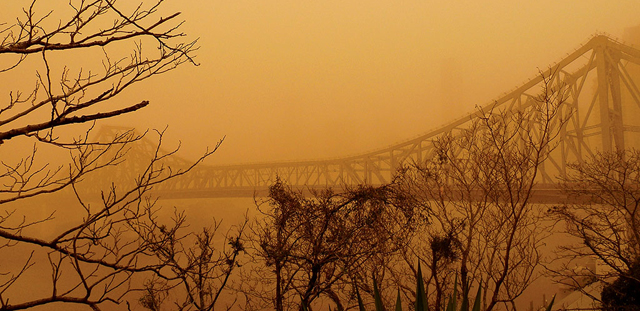sierraclub.org - sierra magazine - march/april 2013 - distant dust
Distant Dust
by Rachael Monosson
 The Story Bridge fades into thick dust in Brisbane, 2009. | Photo by Susan Starr
The Story Bridge fades into thick dust in Brisbane, 2009. | Photo by Susan Starr
Lorikeets perched on the telephone line, french fries dipped into sweet chili sauce, Christmas trees decorating a subtropical summer—Australia can seem so strange to a foreigner that even the sky turning the color of egg yolks doesn't feel out of place.
I was studying abroad in Brisbane in the austral spring of 2009, and I didn't notice the oddly tinted sky until I stepped outside after class, in search of a quiet picnic table for a video chat with my family back home. The sky was soupy, like a foggy morning in San Francisco, only yellow instead of gray. I couldn't smell the dust, couldn't see it, but it accumulated inexorably on my hands, clothes, and computer, obscuring the keyboard's letters by the time I was done with my call.
The news called it a dust storm, though it happened so quietly that "storm" seemed a misnomer. There was no wind, no swirling clouds, just an inescapable settling that lasted less than a day. The dust had come from Australia's desert heart, and as it blew past Brisbane, it fertilized the Tasman Sea, kindling plankton blooms. It was an example of a natural process that I've long found fascinating: how the wind carries life from one part of the world to another.
To get an idea of the scale of this phenomenon, picture the Amazon rainforest. A vast sea of green, branches layered on branches like interlocked fingers, a flooded and mosquito-ridden wonder, a creator of clouds, home to the jaguar, the piranha, the toucan, the capybara. One would think that such a forest would spring from rich soil. But as it turns out, the heavy equatorial rain leaches away terrestrial nutrients, leaving only an inch or two of topsoil, beneath which is nothing but acidic red clay. How can trees more than 100 feet tall, lush with orchids and bromeliads and heavy with chattering monkeys and parrots, grow in such soils? How can so little substance generate so much life?
The answer lies more than 4,000 miles away, on the other side of the Atlantic, in an inhospitable landscape of endless dunes and relentless wind. The Sahara Desert is nearly as large as the United States, and while its climate is dry, its sand is rich in minerals, which is just what the Amazon needs. About 45 million tons of dust stream from Africa to South America every year, giving life to Amazonian clay. Scientists discovered in 2006 that half of the Amazon's iron and phosphorous comes from a single dried lake bed in Chad.
But wind carries much more than dust. Many forms of life ride it like tiny hitchhikers. Fungal spores, pollen, and seeds routinely float across the sky to new homes. These in turn carry bacteria and viruses. The sky even has its own permanent ecosystem of microbes, drinking from clouds and eating from the spores swept to them by the wind. Called the "aeroplankton," this airborne biome also includes hatchling spiders, caterpillars, and mites thatdisperse by weaving kites of silk and soaring away like paragliders. Some fly only a few feet, while others hit updrafts and balloon thousands of feet into the air, joining the upswept millions of winged insects, from termites to butterflies, that also ride the wind. If they ascend high enough, the jet stream can carry these flying invertebrates across oceans and to the tops of mountains. Charles Darwin recorded that ballooning spiders landed on the Beagle hundreds of miles out at sea.
Wind pays no attention to national boundaries, and it doesn't always bring life. Airborne mercury from Asia can reach North America in as little as four days, accompanied by black carbon, ozone, and other pollutants. In return, the United States passes on up to three-quarters of its own mercury pollution, letting it fall wherever the wind takes it. In a very literal sense, we breathe the same air that the Chinese do, and they breathe the same as us.
My laptop pulled through its unexpected dusting, and the storm moved on. Soon the skies were blue and once again filled with the screeching of lorikeets. Some weeks later, the desert grit left behind on my computer would again become airborne, packed in a carry-on. I like to think that some of it is still there, under my keyboard, even as I type this today.
Rachael Monosson is an intern at Sierra.